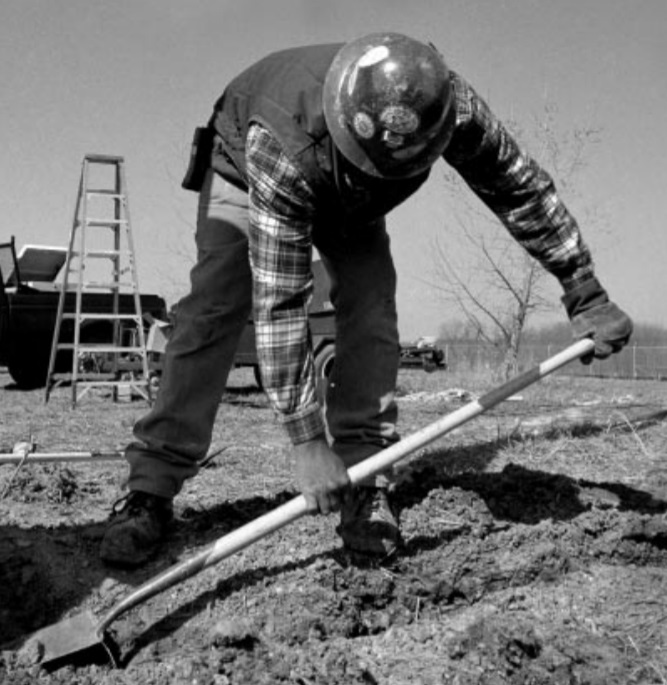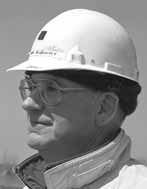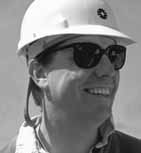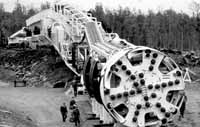NuMI Construction Begins: How to Tell a Neutrino Experiment from a Hole in the Ground
Those who would fathom the secrets of that exotic will-o'-the wisp of the particle kingdom, the neutrino, will first have to deal with a more prosaic form of matter.
Dirt.
They will have to dig over a thousand cubic yards of it from its rightful home near the Main Injector's perimeter, creating a cylindrical hole 24 feet in diameter and 70 feet deep.
Then they'll hit rock. At which point, they'll have a blast. Quite a few blasts, in fact, using carefully controlled explosives to punch through the dolomitic limestone and shale that lie beneath the surface of northeast Illinois.
All that digging and blasting will produce a 200-foot-deep hole in the ground--and the main shaft for the target hall for the NuMI/MINOS experiment, the next step in the world-wide effort to understand neutrino mass.
The NuMI Project
The subatomic particles called neutrinos come in three flavors: electron, muon and tau. Although no experiment thus far has directly observed the change from one neutrino flavor to another, such a change, called oscillation, is quite possible.
Scientists from Fermilab and some 30 other U.S. and foreign institutions have designed a set of facilities, collectively called NuMI, for "Neutrinos at the Main Injector," to search for neutrino mass by looking for evidence of neutrino oscillation from one neutrino flavor to another. The MINOS ("Main Injector Neutrino Oscillation Search") experiment will use these new facilities to take advantage of the unique capabilities of Fermilab's new particle accelerator, commissioned in 1999.
The digging that started in early April marks the start of construction for a new particle beamline. It will direct a nearly pure beam of muon neutrinos from the Fermilab Main Injector toward two detectors, "near" and "far," both capable of detecting and counting all three flavors of neutrinos. If the far detector, 735 kilometers from Fermilab in northern Minnesota, finds another neutrino flavor besides muon neutrinos, the experimenters will know that some of the muon neutrinos that started out at Fermilab must have oscillated, and hence must have mass.
To make the neutrino beam, physicists will send a beam of 120 GeV protons from the Main Injector to a graphite target, creating a secondary beam of pions and kaons. Some of the pions and kaons immediately decay into muons and muon neutrinos. The beam next passes through 750 feet of rock and steel, stopping the muons. Result: a nearly pure beam of muon neutrinos, northward bound.
The MINOS near detector will measure the number of neutrinos in the beam before it leaves Fermilab. The far detector will check the beam again 2.5 milliseconds later, after the neutrinos' near-light-speed trip to Minnesota.
In July, 1999, groundbreaking took place for the Minnesota end of the experiment, where MINOS experimenters will build a 5,000-ton steel and plastic detector half a mile underground in a newly excavated cavern in a historic iron mine.
Now the time has come to build the Fermilab end of the project.
(Fortunately, since neutrinos can and do pass through the earth without so much as slowing down, there is no need for a 735-kilometer tunnel from Illinois to Minnesota--good news for everyone except tunneling contractors.)
Mining for Neutrinos
The 20-month excavation of the Fermilab site will create a main construction shaft; a target hall; a 600-foot "carrier tunnel" to bring protons from the Main Injector; a second, deeper shaft from the surface to the near-detector hall; and a 3,500 ft. tunnel connecting the target hall and the detector hall. It all amounts to a large-scale underground project, even by high-energy physics standards.
"It's like mining," said the project's Fermilab civil construction manager, Chris Laughton.
"It IS mining," corrected NuMI Project Manager Dixon Bogert.
The mining will be carried out by a subcontractor, the S.A. Healy Company of Lombard, Illinois, a firm specializing in underground construction. In February, Fermilab announced the award to Healy of a $30.5 million subcontract, the largest single construction contract, in absolute dollars, ever awarded by the laboratory. Like Fermilab, Healy is part of an international enterprise, Impregilo S.p.A,. Italy's largest contractor and the largest tunneling contractor in the world.
Healy will employ 180 workers in three shifts on the NuMI construction project, said Todd Paige, Healy's on-site spokesman and project safety manager. The project will require a combination of excavation techniques: soil excavation, "drill and blast," "raise-bore" drilling and the use of tunnel boring machines, or TBM's.
Soil excavation will began in early-April, and in May an eight-week period of blasting will follow. A 100-ton crane will bring the raw rock to the surface, where an endless parade of trucks will carry it to a giant rock pile near the Kautz Road substation. (Attention joggers: Recreational use of Kautz Road will be temporarily suspended for the duration of the project.)
In November a still-larger crane will lower a TBM to the bottom of the hole, where it will head northwest at a downward grade of about 6 percent, digging a tunnel 21.5 feet in diameter at a rate of 90 feet per day, trailing an industrial-strength electric power cord behind it.
Workers will then dig a second shaft, this one 350 feet deep, connecting the MINOS near detector hall to the surface. For this shaft, Healy plans a different method, the raise bore technique, starting at the bottom and employing a 14-foot rotating drill bit to dig a center hole. A conveyor in the TBM-dug tunnel will carry the "spoil" to the surface, via the construction shaft. Drill-and blast-around the edges of the shaft will bring it to the required diameter.
Twenty months from the project's start in March, 2000, Healy will deliver to Fermilab a $30.5 million empty hole in the ground, ready to outfit as a neutrino experiment.
A Rough Business
As Fermilab and Healy prepare to break ground, safety concerns are foremost in every project manager's mind. In fact, safety issues influenced prequalification of bidders for the project, according to Fermilab's Laughton.
"We did not allow some contractors, including one large national firm, to bid, because of inadequate safety records," he said.
"Our goal is to finish this project without any serious injury," said Fermilab's Bogert. "This is a rough business, and it is inherently dangerous. But if attention is paid, we can reduce the hazards to an absolute minimum. That is our aim."
Healy's Paige echoed Bogert's determination.
"Nationally, mining is five times more hazardous than typical heavy construction," he said. "While the number of lost workdays per 200,000 hours is 2.2 for heavy construction, for mining and tunneling it is 10.8. For this job, I would love to have zero.
"All hands are responsible for safety. The lowest laborer on this job knows he can stop the work for safety concerns without repercussions."
Paige described a company safety policy similar to Fermilab's Integrated Safety Management, with hazard analyses for each task, frequent workplace safety meetings, and extensive and targeted safety training. And as part of the project contract, he said, personnel from the Fermilab Fire Department will receive specialized mine rescue training from Healy, creating an on-site mine rescue team, ready to act if the need arises.
"What was that?"
While much of the excavation will take place with little effect on surrounding areas, when blasting for the main NuMI shaft begins, people at Fermilab and in nearby neighborhoods will hear and feel it. However, according to Paige, the strength and duration of the blasts will be limited, to prevent damage to nearby accelerator tunnels.
"We will use less powder and a wider pattern for blasting than for some other jobs," Paige said. "Nearby neighbors will hear a series of sounds, something like a cannon in the distance. It won't shake their house, and it won't break their windows. There's a science to this. There won't be any flying rock."
Fermilab project personnel have carried out studies to establish baseline levels of ambient sound and ground vibration, and Fermilab and Healy staff plan to meet with neighborhood groups to let them know what to expect when the blasting starts.
"We don't expect any significant problems for our neighbors, but we don't want them to wonder --What was that?'" Laughton said.
Ready to Go
As NuMI groundbreaking nears, there is a sense of sober excitement in the construction trailers that will be home to NuMI's Fermilab and subcontract staff for the next two years.
"After working on government jobs in the past, I was a little leery of what it would mean working at Fermilab," Paige said. "But the people on this project know what they are doing. There is expertise in both above-ground and underground work. Clearly, Fermilab doesn't put unqualified people in these positions. All of them are very professional."
For his part, Laughton, a Ph.D. engineer with degrees in rock mechanics and mining, who has spent much of his own career as a tunneling designer and contractor, mused about the particular difficulties of the NuMI job.
"The main challenge for the contractor," Laughton said, "will be to make efficient use of a wide range of technologies. There's a learning curve associated with each one. It takes a certain amount of time for even an experienced crew to get into the rhythm of each task. Here, they'll just hit their stride and it will be time to change to something new."
And despite exhaustive analysis and careful planning, the nature of tunneling means that the construction project is bound to hold surprises, Laughton said.
"That's why you can't run tunneling jobs from an office. You need full-time experts underground. Because one thing you can be sure of is that things aren't going to turn out exactly the way you think."
Not unlike the story of neutrinos.






